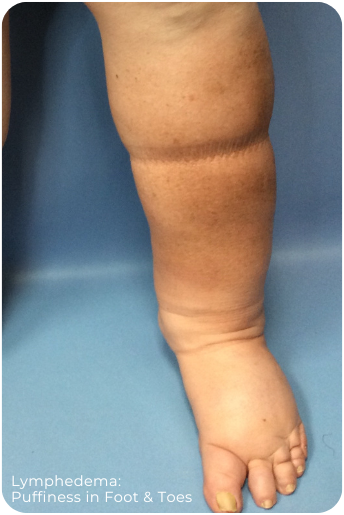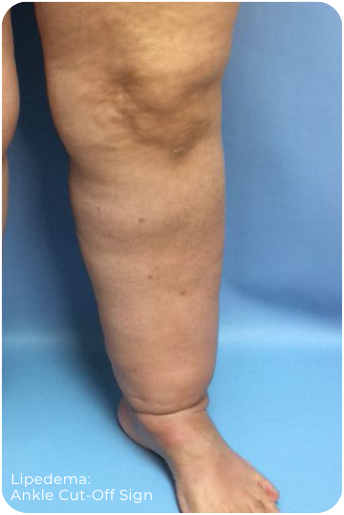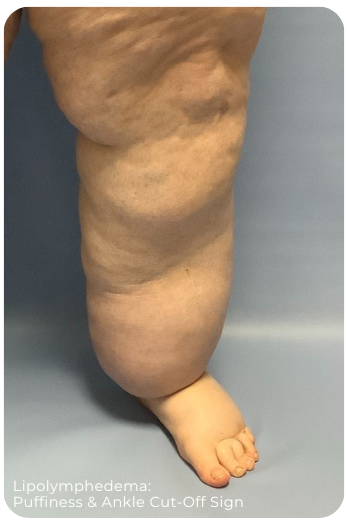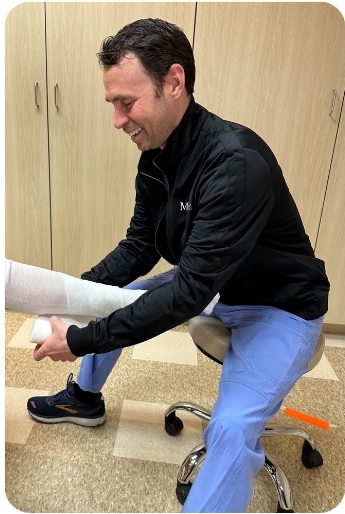At Miller Vein, our board-certified physicians and Certified Lymphedema Therapists specialize in treating problems related to the lymphatic system, like lymphedema, lipedema, and chronic venous insufficiency. They have undergone advanced, specialized training and are experts in diagnosing and treating these conditions, in addition to their surgical and interventional backgrounds.
Lymphedema

Lymphedema is a progressive disease caused by a disruption of the lymphatic system. Lymphatic vessels drain fluid from tissue and return it to the bloodstream. Interruption of this flow causes an abnormal buildup of fluid.
Primary lymphedema is a rare genetic condition that affects the development or function of the lymphatic system. Secondary lymphedema is far more common. Causes include chronic venous insufficiency, obesity, cancer, surgery, radiation therapy, injury, and infection.
Common signs and symptoms of lymphedema include:
- Swelling or puffiness in the foot and toes.
- Aching, heaviness, tightness, or pain in the affected limb which may worsen over time.
- Limited range of motion or fatigue in the affected limb.
- Skin changes, such as thickening or hardening, or discoloration.
- Recurring infections, such as cellulitis or lymphangitis, in the affected area.
- Wounds or weeping lymph fluid through the skin.
Lipedema

Lipedema is a chronic and progressive condition that primarily affects women and is characterized by the abnormal accumulation of fat in the legs or arms. Lipedema typically occurs symmetrically in both legs and can be located from the hips to the ankles. There is a disproportionate appearance when comparing the lower extremities to the upper half of the body.
Common signs and symptoms of lipedema include:
- Symmetrical leg fat accumulation with normal feet leading to the ankle cut-off sign.
- Swelling and tenderness in the affected areas.
- The presence of small nodules or lumps beneath the skin.
- Easy bruising of the involved areas.
- Pain and discomfort in the affected areas.
“I will say I have never experienced so much care and professionalism from a doctor’s office before. From the moment you walk in, to the very moment that you leave they’re always smiling and very helpful.”
– J.A., Miller Vein Patient
Combined Disease
Lipedema, lymphedema, chronic venous insufficiency, and obesity can all happen together in various combinations, resulting in different symptoms and the appearance of the legs. When lipedema and lymphedema occur at the same time, it’s called lipolymphedema.

As noted above, lipedema involves an abnormal buildup of fat cells, typically in the legs, causing them to appear disproportionately larger compared to the rest of the body. Lymphedema, on the other hand, occurs when there’s an issue with the lymphatic system, which normally removes excess fluid and waste from the body tissues. The most common cause of lymphedema is chronic venous insufficiency.
With lipolymphedema, the combination of lipedema and lymphedema results in swelling, discomfort, and reduced mobility. The affected areas may feel painful, numb, or heavy.
Certified Lymphedema Therapy
A certified lymphedema therapist (CLT) is trained in specialized care for lymphatic disorders. They have a deep understanding of the anatomy and physiology of the lymphatic system and are trained to identify and address any underlying medical issues that may contribute to these conditions.

A CLT can help manage lymphedema, lipedema, and other conditions by providing four components of compete decongestive therapy:
- Manual lymphatic drainage
- Compression
- Decongestion exercises
- Skin and nail care
After working with a certified lymphedema therapist, patients will learn how to manage their condition through lifestyle changes, precautions, diet, exercise, and skin care.
“After seeing several doctors, it was nice to find a place that treated me well and, more importantly, had a diagnosis and treatment plan after one visit.”
– G.H., Miller Vein Patient
Treatment Options for Lymphedema and Lipedema
Compression Therapy
Compression garments or bandages are used to apply pressure to the affected limb(s), helping to improve lymphatic flow and reduce swelling.
Pneumatic Compression Device
A medical device that uses inflatable cuffs or sleeves to apply pressure to the limbs, helping to improve circulation and reduce swelling in the affected area.
Manual Lymphatic Drainage
Also known as lymphatic drainage massage. Gentle, rhythmic movements that stimulate the lymphatic system and promote the drainage of lymphatic fluid.
Exercise, Nutrition, and Skin Care
Regular exercise, like walking or swimming, can help improve lymphatic flow and reduce swelling. Patients with lymphedema are at increased risk of skin infections, so it’s important to keep the skin clean and moisturized with low pH products to reduce the risk of infection. Proper nutrition and weight management can help those suffering from lipedema.
Venous Ablation
Correction of underlying vein disease through quick in-office procedures helps with symptoms of vein disease including heaviness, aching, swelling and skin ulcers. Early diagnosis and treatment are crucial in preventing complications such as leg ulcers.
“The whole staff there made me really feel comfortable and at ease being there as a patient. It really felt good to go to a new doctor that was friendly and made me acknowledgeable at what I needed to know about the treatment I was going to have.”
– T.F., Miller Vein Patient
Frequently Asked Questions
What is manual lymphatic drainage? Is it a massage?
Although manual lymphatic drainage is commonly referred to as a massage, it is a much gentler therapeutic approach that lightly stretches the skin to stimulate lymph flow, reroute fluids, and drain fluids out of a swollen body part.
Can lipedema and lymphedema go away with weight loss?
Lymphedema and Lipedema can be managed effectively with proper treatment and daily care. However, they are chronic conditions that currently do not have a cure. Weight loss can reduce the strain on the lymphatic system but the accumulation of fat due to lipedema is not affected by typical exercise and diet. This is an area of ongoing research.
What is the difference between excess fat and lipedema?
Excess fat refers to an overall increase in adipose tissue throughout the body. It can occur due to various factors, including poor diet, sedentary lifestyle, hormonal imbalances, and genetic predisposition. Excess fat is typically distributed more evenly throughout the body and may not be limited to specific areas. While excess fat can contribute to health issues like obesity, it is not necessarily accompanied by the same symptoms of pain, tenderness, or swelling as observed in lipedema. People with lipedema often have a disproportional smaller waist and trunk due to this fatty tissue accumulating on the legs. Arms may be involved; however, this is less common.
Does drinking more water help lymphedema?
Drinking enough water daily is always a good idea for your general health. However, drinking more or less water will not affect your lymphedema.
What are the warning signs of lymphedema?
Warning signs include the feeling of heaviness, fullness, or tightness of your limb. Also, be aware if clothing does not fit the same between both sides of your extremities.
What are the risks and complications of lymphedema?
There are several precautions to follow if you have lymphedema. Avoid heat, extreme cold, tight-fitting clothing, injury, blood pressure cuffs, insect bites, sunburns, needle pokes, prolonged standing or sitting, strenuous exercises, trauma, and infections.
When shaving, use a safety razor to avoid cuts. Also, keep skin clean and apply low-pH moisturizing lotion daily. Clean skin breaks with soap and water, apply topical antibiotics, and monitor for signs of infections.
What are the signs of infection that I should look out for?
Signs of infection can include rash, itching, redness, pain, increased skin temperature, increased swelling, fever, or flu-like symptoms. Contact your doctor immediately for any of these symptoms.
I tried compression stockings in the past and they didn’t work. I couldn’t get them on, and they hurt. What now?
Selection of proper compression is an art form that addresses several factors including circumstances of swelling, lifestyle, skin conditions, ability to put them on, and fashion. Your Certified Lymphedema Therapist will coordinate with you to select the proper compression and will train you on efficient methods of getting them on and off.

